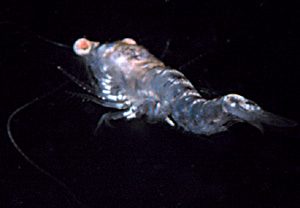Krill — Order Euphausiacea
Euphausiids, also known as krill, are small, shrimp-like crustaceans that live within the water column. They are entirely marine, and arctic waters contain 6 of the 85 species described worldwide.
Krill possess six to eight pairs of appendages on their body, each of which bears a long fringe of bristles that are used to trap food. External gills are located at the base of a shield-like structure that covers their head. Five pairs of appendages extend from the abdomen and act as swimming legs.
Many euphausiids contain a special material that allows them to “glow in the dark,” a process called bioluminescence. It is believed that bioluminescence is an adaptation to communicate information about swarming and reproduction.
Arctic krill have adopted a “polar adaptation”: seasonal vertical migration. During the winter, individuals sink deep down in the ocean and slow their metabolism. In this way, they are able to conserve the energy that is required for successful reproduction the next spring.
Fertilized euphausiid eggs are either shed into the water or retained in a special sac within the females. Like most crustaceans, young euphausiids moult – shed their skeleton – several times before reaching maturity. They are unique, however, in that they continue to moult as adults. In the absence of an adequate food supply, euphausiids can even decrease their size with successive moults!
Most krill are filter feeders, consuming algae, other protists, or tiny animals living within the water column. Many euphausiids, themselves, are important dietary components for a number of arctic marine animals, including squids, fishes, and especially bowhead whales.

